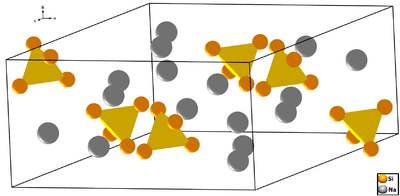Zintl phase
In chemistry a Zintl phase is the product of a reaction between a group 1 (alkali metal) or group 2 (alkaline earth) and any post transition metal or metalloid (i.e. from group 13, 14, 15 or 16). It is named after the German chemist Eduard Zintl who investigated them in the 1930s,[1] with the term "Zintl Phases" first used by Laves in 1941.[2]
Zintl phases are a subgroup of brittle, high melting point intermetallic compounds which are diamagnetic or exhibit temperature-independent paramagnetism, are poor conductors or semiconductors.[3] Zintl noted that there was an atomic volume contraction when these compounds were formed and realised this could indicate cation formation.[3] He suggested that the structures of Zintl phases were ionic, where there was complete electron transfer from the more electropositive metal.[3] The structure of the anion (nowadays called the Zintl ion) should then be considered on the basis of the resulting electronic state. These ideas were further developed to become the Zintl rule or Zintl Klemm concept, where the polyanion structure should be similar to an isoelectronic element.[1]
Examples
A Zintl phase is the product of a reaction between
- group 1 (alkali metals) or group 2 (alkaline earths) and
- post transition metals or metalloids from group 13, 14, 15 or 16.
Examples of Zintl phases:
| Example | Structure |
|---|---|
| • NaTl: it is now known that the structure consists of a polymeric anion (—Tl−—)n with a covalent diamond structure with Na+ ions located between the anionic lattice.[1] |  Framework of Tl− ions in the NaTl structure |
| • NaSi: the polyanion is tetrahedral (Si4)4−, similar to phosphorus molecule P4.[1] |  Crystal structure of NaSi with Si4 tetrahedra |
| • Na2Tl: the polyanion is tetrahedral (Tl4)8−, similar to phosphorus molecule P4.[4] | --- |
Clathrates are another instance of Zintl phases with potential for thermoelectric power generation, as their rattling structure results in low thermal conductivity.
Zintl line
The Zintl line is a hypothetical boundary drawn between group 13 and group 14, to highlight the tendency for group 13 metals to form phases with a variety of stoichiometries, which contrasts to group 14 and above that tend to form salts with polymeric anions. It is now recognised that some Zintl phases contain Zintl clusters and that this accounts for the variable stoichiometries. The bonding in many of these clusters cannot be accounted for by classical octet rule involving covalent, 2-centre, 2-electron bonds, as implied by the Zintl rule. The reaction of Ge, Sn or Pb and Na in liquid NH3 in the presence of ethylene diamine (en) gives the Zintl cluster Na4en7Sn9.[5]
Exceptions
There are examples of a new class of compounds that, on the basis of their chemical formulae, would appear to be Zintl phases, e.g., K8In11,[6] which is metallic and paramagnetic. Molecular orbital calculations have shown that the anion is (In11)7− and that the extra electron is distributed over the cations and, possibly, the anion antibonding orbitals.[6]
See also
References
- 1 2 3 4 S.M. Kauzlarich, Encyclopedia of Inorganic chemistry, 1994, John Wiley & Sons, ISBN 0-471-93620-0
- ↑ Zintl Phases: Principles and Recent Developments, Book Series: Structure and Bonding. T. F. Fässler (Ed.), Volume 139, Springer, Heidelberg, 2011 (DOI 10.1007/978-3-642-21150-8)
- 1 2 3 Sevov, S.C., Zintl Phases in Intermetallic Compounds, Principles and Practice: Progress, Westbrook, J.H.; *Freisher, R.L.: Eds.; John Wiley & Sons. Ltd., Chichester, England, 2002, pp. 113-132 Slavi Chapter
- ↑ Cotton, F. Albert; Wilkinson, Geoffrey; Murillo, Carlos A.; Bochmann, Manfred (1999), Advanced Inorganic Chemistry (6th ed.), New York: Wiley-Interscience, ISBN 0-471-19957-5
- ↑ Greenwood, Norman N.; Earnshaw, Alan (1997). Chemistry of the Elements (2nd ed.). Butterworth-Heinemann. ISBN 0-08-037941-9.
- 1 2 Slavi C. Sevov; John D. Corbett (1991). "A remarkable hypoelectronic indium cluster in K8In11". Inorg. Chem. 30 (26): 4875–4877. doi:10.1021/ic00026a004.